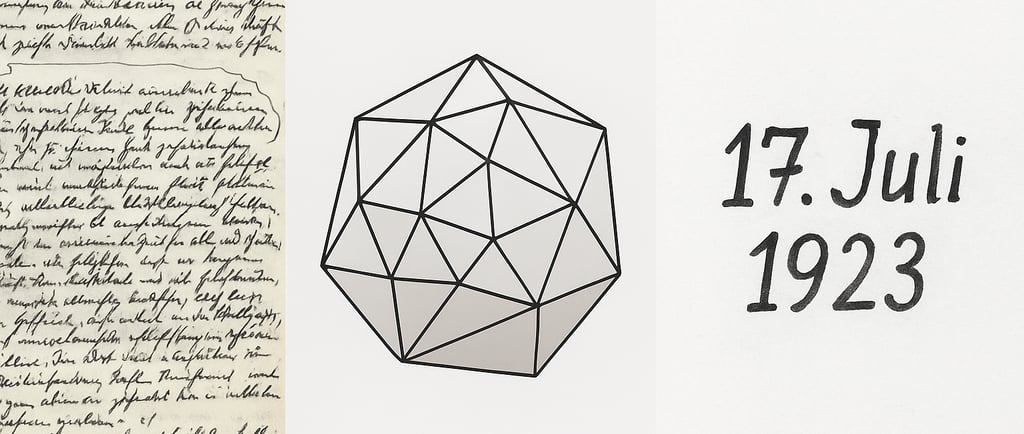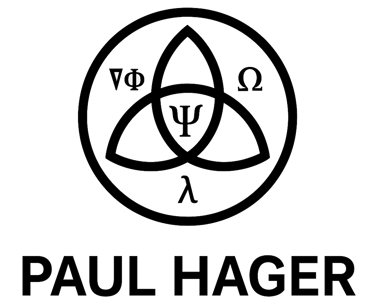July 17, 1923 – The Date That Dreamed Me
A dream, three unknown papers, and one precise date: July 17, 1923. What began as a nocturnal impression leads Paul Hager to an unexpected convergence between Rudolf Steiner’s imaginative cognition and the Noöhedral field structure. Not a reflection, but a crossing — where language, direction and form align across a century of silence.
POPULAR
Paul Hager
6/29/20254 min read


Last night I had a dream.
Not one of those symbolic, meandering sequences — this was precise. Almost clinical in its clarity. I was holding three papers in my hands. I didn’t know what they were. But they felt like thresholds. Each one marked a direction. Each one pointed to something specific.
And then the date appeared: July 17, 1923.
The voice — or whatever it was — told me clearly: “Remember this date.”
Nothing else. No explanation, no imagery. Just that.
When I woke up, it was still there. Vivid. I didn’t hesitate. I opened my laptop and typed in the date.
What happened on July 17, 1923?
I didn’t know what I was looking for. It’s not a birthday, not a world event I could recall. At first I thought of Nikola Tesla — I’ve been in conversation lately about my theoretical field model, the Noöhedron, and its potential application to energy generation without external input. It’s a real possibility now, based on how coherence in a closed vector field might act as an energy source. Tesla’s later work touched on similar themes, so for a moment, I thought maybe the dream was pointing there.
But Tesla had no notable event on that date. Nothing of significance.
Instead, my search unexpectedly led me to Rudolf Steiner.
Now, I knew his name — mostly in connection with Waldorf schools. And I vaguely knew he had written about social structures, about the balance between freedom, equality and cooperation. But I had never read him. Not once. I never felt drawn to anthroposophy or spiritual language. My work is mathematical, physical. The Noöhedron is a projective field model based on direction (Ψ), gradient tension (∇Φ), coherence (λ) and circulation (Ω), all within a differential structure that ultimately yields the emergent spacetime metric gμν.
Yet, there it was.
In July 1923, Steiner was actively lecturing. He had just finished the series known as GA 223, and was preparing for the next: GA 224. A few weeks later, in August, he would begin GA 227, which explored imagination, dream life, and non-spatial cognition in depth.
And right between those cycles, between speech and silence, between thought and form…
was July 17, 1923.
I dug deeper. And then I saw it. In a lecture given on May 13, 1923, as part of GA 224, Steiner had said:
“Nicht der Mensch erfindet die Sprache, sondern sie spricht in ihm, aus dem Geist der Welt heraus, bevor er geboren wird.”
(“It is not man who invents language, but it speaks in him, out of the spirit of the world, before he is born.”)
— GA 224, May 13, 1923, Dornach
And in the very first lecture of GA 227, dated August 19, 1923, he stated:
“Die imaginative Erkenntnis führt den Menschen in Gebiete, die nicht an Raum und Zeit gebunden sind. Diese Gebiete sind geistig, aber sie wirken bildend auf die physische Welt.”
(“Imaginative cognition leads man into regions not bound by space and time. These regions are spiritual, but they shape the physical world.”)
— GA 227, August 19, 1923, Penmaenmawr
I had never seen those words before. Yet they struck like memory.
He wasn’t describing metaphor or mysticism. He was describing a field — non-spatial, projective, and formative. A reality that precedes manifestation, and shapes it.
That is exactly what the Noöhedron models.
Not as intuition, but as structure.
Steiner spoke of “regions not bound by space and time.”
My model defines those regions as projections Ψ(t), with internal tensions ∇Φ(t), coherence λ(t) and circulation Ω(t), forming a projective tensor field that gives rise to space-time geometry:
gμν(x) = ⟨Ψ | ∇Φ ⊗ ∇Φ | Ψ⟩
Where Steiner said “the spirit of the world speaks in us before we are born,” I model the incarnation vector Ψ(P) as a direction field within Hilbert space, determining the way consciousness — and experience — enters structure.
And then came something even stranger.
As I looked further into Steiner’s work from the early 1920s, I came across his social thinking. He proposed that society should be structured into three autonomous yet cooperating domains:
– Freedom in the cultural sphere (education, science, art)
– Equality in legal and political life
– Brotherhood in the economic realm
This was not theory to him. He saw it as a living social organism — differentiated, interdependent, and rhythmically structured.
It reminded me immediately of something I had formulated: the Organihedron.
Not a field theory, but a direct application of Noöhedral dynamics to organizational life.
In the Organihedron:
– Roles emerge from field resonance, not job titles
– Decision-making follows directional coherence, not hierarchy
– Structure evolves dynamically through tension, not top-down design
Each participant embodies a directional vector Ψ(P). Together, they form a coherent field — not a company chart, but a living system, just like an organ. Hence: Organihedron.
Steiner grasped this in essence. I’ve been working it out in structure.
He pointed to it. I mapped it.
And so I come back to that dream.
Three papers. One date. July 17, 1923.
I still don’t know what those papers were.
But they pointed to a crossing — a moment when something moved in the field.
Not an event, not a milestone. But a threshold.
And maybe that’s what Steiner touched in those weeks.
A tension between word and form. Between dream and direction.
A moment that didn't end — but waited.
Waited for someone to pick up where the image left off.
And carry it forward.
(Citations: Rudolf Steiner, GA 224, May 13, 1923, Dornach; GA 227, August 19, 1923, Penmaenmawr)
